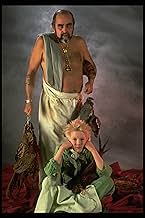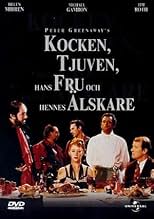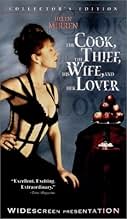Il cuoco, il ladro, sua moglie e l'amante
Titolo originale: The Cook, the Thief, His Wife & Her Lover
La moglie di un violento criminale trova conforto tra le braccia di un gentile ospite abituale nel ristorante del marito.La moglie di un violento criminale trova conforto tra le braccia di un gentile ospite abituale nel ristorante del marito.La moglie di un violento criminale trova conforto tra le braccia di un gentile ospite abituale nel ristorante del marito.
- Premi
- 7 vittorie e 11 candidature totali
Ciarán Hinds
- Cory
- (as Ciaran Hinds)
Roger Ashton-Griffiths
- Turpin
- (as Roger Ashton Griffiths)
Recensioni in evidenza
I sat transfixed by this film's ability to become increasingly depraved, always without any redeeming quality whatsoever. We would have left except that I became fascinated by the ability of the director and writer to hit bottom and then keep drilling. The story is familiar enough but there are no protagonists. There really are no antagonists either. Just a bunch of people you care nothing about doing things you don't want to know about. If a friend did this stuff to another human and wanted to tell you about it, you would scream for him/her to stop.
To top it off it has a score by Michael Nyman who had just enough talent to write one bad film score and retreads it for every film that a producer is stupid enough to hire him to score.
To top it off it has a score by Michael Nyman who had just enough talent to write one bad film score and retreads it for every film that a producer is stupid enough to hire him to score.
I saw this almost fifteen years ago and I still have crystal clear mental images of some of the scenes. The chef at his table in the kitchen, planning his menu: stunning! Put it in a frame, hang it on the wall. In the restaurant scenes, you feel like you're there at the table as the camera pans, without cuts, from one person to another. Our heroes locked in the truck full of rotting meat: horrible, disgusting, perfect. It's a classic purification ritual and it's literally putrid. Greenaway is a genius. My only criticism is a minor one. There is a full frontal nude scene of the wife and her lover, where he is clearly more "relaxed" than he should have been at that moment. I'm a bit disappointed in Greenaway for not showing him at "attention", as he would have been in real life. But then, I guess he would have been accused of making porn. Whatever. This film is not for everyone. My wife didn't see it. I'm sure she would have hated it if she had. For that matter, I can't actually say I liked it, although I consider it a masterwork. But I'm glad I saw it. I'll probably see it again, but not until I can see it on HDTV. Plain old DVD couldn't possibly do it justice. An amazing movie.
The cruel and sadistic crime boss Albert Spica (Michael Gambon) has dinner every night in his restaurant with his wife Georgina Spica (Helen Mirren) and his gang. Albert abuses of his wife, his gangsters, the chef Richard Borst (Richard Bohringer) and the restaurant employees.
When Georgina meets the gentle bookseller Michael (Alan Howard) in the restaurant, they have a torrid affair in the restroom and in the store, and they are covered by Richard. However the prostitute Pat discloses to Albert that he has been betrayed by Georgina and Albert kills Michael. However Georgina plots revenge against Albert with the support of Richard and the victims of Albert.
"The Cook the Thief His Wife & Her Lover" is one of the most grotesque, eschatological, bizarre and weird films that I have ever seen. But it is also absolutely original and mesmerizing, with intense use of colors, and with the contrast of vulgarity and art. Food, eschatology, sex, cruelty, torture, cannibalism and revenge are entwined along 124 minutes running time. The result is not pleasant and only specific audiences will appreciate this film. Last time I had seen this film was on 08 September 2000 on VHS. My vote is eight.
Title (Brazil): "O Cozinheiro, o Ladrão, Sua Mulher e o Amante" ("The Cook the Thief, His Wife and the Lover")
When Georgina meets the gentle bookseller Michael (Alan Howard) in the restaurant, they have a torrid affair in the restroom and in the store, and they are covered by Richard. However the prostitute Pat discloses to Albert that he has been betrayed by Georgina and Albert kills Michael. However Georgina plots revenge against Albert with the support of Richard and the victims of Albert.
"The Cook the Thief His Wife & Her Lover" is one of the most grotesque, eschatological, bizarre and weird films that I have ever seen. But it is also absolutely original and mesmerizing, with intense use of colors, and with the contrast of vulgarity and art. Food, eschatology, sex, cruelty, torture, cannibalism and revenge are entwined along 124 minutes running time. The result is not pleasant and only specific audiences will appreciate this film. Last time I had seen this film was on 08 September 2000 on VHS. My vote is eight.
Title (Brazil): "O Cozinheiro, o Ladrão, Sua Mulher e o Amante" ("The Cook the Thief, His Wife and the Lover")
10miloc
Here's the weird secret of this movie: you might actually enjoy it.
Peter Greenaway once commented, "film is too important to be left in the hands of story- tellers." Like almost everything Godard ever said, it's a preposterous statement that ought to be heeded.
As a filmmaker Greenaway has always delighted in puzzle-pictures; from the twin-based symmetry of "A Zed and Two Naughts" to the subliminal counting-game of "Drowning by Numbers" to the mad frames-within-frames of "Prospero's Books" his films resemble nothing so much as one of Graeme Base's wonderful children's' books ("The Eleventh Hour" and "Animalia" for instance) brought to life. Plus, of course, a great deal of nudity and assorted nastiness-- enough to get the works of one of the most original filmmakers living a rather sordid reputation.
So, once you've recovered from the visceral shock of watching "The Cook, the Thief, His Wife and Her Lover" the first time, take a step back and watch it again. Yeah, I mean that, do it. Look at it this time as you might a painting by Heironymus Bosch: what appears to be a madman's chaotic hellscape turns out to have a precise allegorical order, and contains such a wealth of symbolism that one viewing cannot possibly be enough to absorb it all. A scene that may seem gratuitously horrific (a naked couple enclosed in a truck full of rotting meat-- probably the moment that jolted me the most) in fact reveals a medievalist's precision (Adam and Eve, cast from Paradise for the First Big Sin, are suddenly subject to the corruption of the flesh). An abstract concept is thus made perfectly and accessibly literal.
Different viewers may prefer to see this movie as religious allegory, political screed, or wry class commentary. The fact is it is all of these, and probably more. The irony of Greenaway's quote above is that he is in fact story-telling on several levels at once. (It's the same irony in the comment that "Seinfeld" was a "show about nothing" when in fact there was more going on per episode than in any other ten sitcoms. It just wasn't "simple.")
In response to criticism over the bloodshed in his movies, Godard once said "It isn't blood, it's red." Meaning: it's all part of a composition, the way color is used on a painter's canvas. It's there for a point, just like Greenaway's explicit yet elegant shocks. With that mind, watch this movie, and enjoy it. It's sharp, gruesomely witty, and as remarkable to look at as almost anything in the Met. If you can handle really thinking, you can handle this, and we all can, can't we?
Peter Greenaway once commented, "film is too important to be left in the hands of story- tellers." Like almost everything Godard ever said, it's a preposterous statement that ought to be heeded.
As a filmmaker Greenaway has always delighted in puzzle-pictures; from the twin-based symmetry of "A Zed and Two Naughts" to the subliminal counting-game of "Drowning by Numbers" to the mad frames-within-frames of "Prospero's Books" his films resemble nothing so much as one of Graeme Base's wonderful children's' books ("The Eleventh Hour" and "Animalia" for instance) brought to life. Plus, of course, a great deal of nudity and assorted nastiness-- enough to get the works of one of the most original filmmakers living a rather sordid reputation.
So, once you've recovered from the visceral shock of watching "The Cook, the Thief, His Wife and Her Lover" the first time, take a step back and watch it again. Yeah, I mean that, do it. Look at it this time as you might a painting by Heironymus Bosch: what appears to be a madman's chaotic hellscape turns out to have a precise allegorical order, and contains such a wealth of symbolism that one viewing cannot possibly be enough to absorb it all. A scene that may seem gratuitously horrific (a naked couple enclosed in a truck full of rotting meat-- probably the moment that jolted me the most) in fact reveals a medievalist's precision (Adam and Eve, cast from Paradise for the First Big Sin, are suddenly subject to the corruption of the flesh). An abstract concept is thus made perfectly and accessibly literal.
Different viewers may prefer to see this movie as religious allegory, political screed, or wry class commentary. The fact is it is all of these, and probably more. The irony of Greenaway's quote above is that he is in fact story-telling on several levels at once. (It's the same irony in the comment that "Seinfeld" was a "show about nothing" when in fact there was more going on per episode than in any other ten sitcoms. It just wasn't "simple.")
In response to criticism over the bloodshed in his movies, Godard once said "It isn't blood, it's red." Meaning: it's all part of a composition, the way color is used on a painter's canvas. It's there for a point, just like Greenaway's explicit yet elegant shocks. With that mind, watch this movie, and enjoy it. It's sharp, gruesomely witty, and as remarkable to look at as almost anything in the Met. If you can handle really thinking, you can handle this, and we all can, can't we?
My introduction to Greenaway was `Prospero's Books,' which I rate very highly. I next saw `The Pillow Book,' which also was magic. I now delve into this earlier work, which is before Greenaway became master of overlayed windows. And also before he developed (at least in the two films mentioned) a clean sense of layering allegory.
In this early film the sense of allegory is simplistic, and the notion of narrative is largely abandoned. All in all, this is a cleaner film. Greenaway's fulcrum is the creation of a massive clockworks kitchen with dozens of concurrent, interrelated processes. Everything revolves around this, or more precisely the vision of this. Around this center, we see both vile and sublime forces acting on the kitchen, which is a sort of metalevel over the world from which creation emanates.
I suppose many will remember some of the more disturbing incidental images. Not me. I'll remember that extraordinary kitchen.
In this early film the sense of allegory is simplistic, and the notion of narrative is largely abandoned. All in all, this is a cleaner film. Greenaway's fulcrum is the creation of a massive clockworks kitchen with dozens of concurrent, interrelated processes. Everything revolves around this, or more precisely the vision of this. Around this center, we see both vile and sublime forces acting on the kitchen, which is a sort of metalevel over the world from which creation emanates.
I suppose many will remember some of the more disturbing incidental images. Not me. I'll remember that extraordinary kitchen.
Lo sapevi?
- QuizThe four title characters were named for the actors and actress writer and director Peter Greenaway originally wanted to play them. Richard (The Cook) was for Richard Bohringer, the only one of Greenaway's original choices retained in the final movie. Albert (The Thief) was named after Albert Finney, while Georgina (His Wife) was for Georgina Hale. Michael (The Lover) was named, interestingly enough, for Sir Michael Gambon, who Greenaway eventually re-cast as Albert.
- BlooperWhen Albert (Michael Gambon) goes into the ladies' toilet and starts throwing women out of the cubicles, the second one has, as you would expect, her underwear around her knees. But her skirt rides right up, revealing that she is still wearing her underwear and that the ones below are a prop.
- Curiosità sui creditiClosing credits epilogue: "And a special thanks to those very many people who patiently & repeatedly performed as patients & nurses in the hospital ward, and as diners in the Hollandais Restaurant."
- Versioni alternativeAn edited, R-rated version is available on video.
I più visti
Accedi per valutare e creare un elenco di titoli salvati per ottenere consigli personalizzati
Dettagli
- Data di uscita
- Paesi di origine
- Sito ufficiale
- Lingue
- Celebre anche come
- El cocinero, el ladrón, su esposa y su amante
- Luoghi delle riprese
- Aziende produttrici
- Vedi altri crediti dell’azienda su IMDbPro
Botteghino
- Lordo Stati Uniti e Canada
- 7.724.701 USD
- Fine settimana di apertura Stati Uniti e Canada
- 252.223 USD
- 8 apr 1990
- Lordo in tutto il mondo
- 8.527.316 USD
- Tempo di esecuzione
- 2h 4min(124 min)
- Colore
- Proporzioni
- 2.35 : 1
Contribuisci a questa pagina
Suggerisci una modifica o aggiungi i contenuti mancanti






































